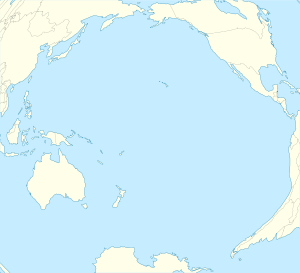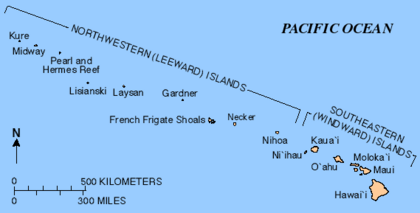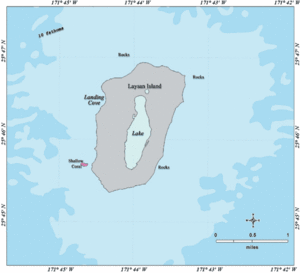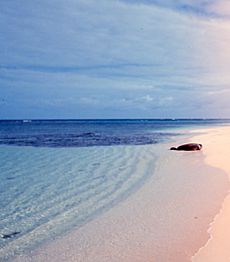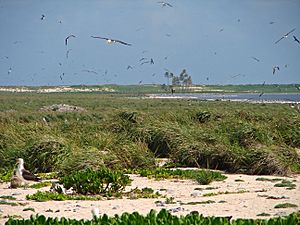Laysan facts for kids
Laysan (which Hawaiians call Kauō) is a small island far northwest of Honolulu. It's about 808 nautical miles (1,496 km) away. Laysan is part of the Northwestern Hawaiian Islands.
The island is about 1 mile (1.6 km) by 1.5 miles (2.4 km) in size. It's like a special kind of island called an atoll. This means the land completely surrounds a shallow lake in the middle. This lake is about 8 feet (2.4 m) above sea level. Its water is three times saltier than the ocean! The Hawaiian name Kauō means egg.
Contents
Island Formation and Features
Laysan is the second largest single landmass in the Northwestern Hawaiian Islands. Only Sand Island at Midway Atoll is bigger. Laysan formed from coral growing and the land slowly rising. The coral reefs around the island cover about 735 acres (2.97 km²).
Lake Laysan
The lake in the middle of Laysan is about 100 acres (0.40 km²) in size. It's a brown, very salty lake. Its depth has changed a lot over the years. In the 1860s, it was up to 30 feet (9.1 m) deep. But by the 1920s, it was only 3 to 5 feet (0.9 to 1.5 m) deep. This happened because sand blew into it during sandstorms.
If you need fresh water on Laysan, you can watch where the finches drink. Fresh water floats on top of the saltier water and gathers near the shore. The highest point on the island is a large sand dune. It reaches about 50 feet (15 m) above sea level.
Future of the Island
A study by the United States Geological Survey found something important. Islands like Laysan and Midway Atoll could be covered by water in the future. This means they might become too wet for living things to survive this century.
Island History
People from Hawaii might have known about Kauō long before European and American ships arrived. The first reports of the island by outsiders were from Massachusetts whalers in the 1820s. They were sailing in the Pacific for whaling.
Early Discoveries and Ownership
In 1828, a U.S. government survey included reports from these whalers. It also mentioned a sighting by Captain "Brigs." This might have been Captain John Briggs, who could have seen the island as early as 1822. Later, in 1857, Captain John Paty officially added Laysan to the Kingdom of Hawaiʻi.
Guano Mining on Laysan
Laysan became important because of guano, which is bird droppings. Guano was used as a fertilizer. In 1859, a ship captain named Brooks said there wasn't enough guano to mine. But in 1890, George D. Freeth and Charles N. Spencer got permission to mine it. They dug out about 100 short tons (91 metric tons) of guano every day.
Working in the guano mine was very hard. In 1900, Japanese workers went on strike against the American managers. This led to violence because of a language barrier. Sadly, two people died and two were hurt.
Impact of Mining and Rabbits
Scientists started visiting Laysan because of the mining. They studied its unique animals and plants. But the guano digging really hurt the island's environment. In 1903, one scientist thought there were 10 million seabirds on Laysan. Eight years later, there were only about a million. During that time, the Pritchardia palms and sandalwood trees unique to Laysan disappeared forever.
In 1894, a German immigrant named Max Schlemmer came to Laysan. He brought domestic rabbits, Belgian hares, English hares, and guinea pigs to the island. He hoped they would multiply so he could start a meat-canning business. This decision was a big problem for Laysan.
Period of Extinction
The rabbits multiplied very quickly. Soon, they ate almost all the plants on the island. People complained about this and about Japanese poachers hunting birds. Because of this, President Theodore Roosevelt made the Northwestern Hawaiian chain a bird sanctuary in 1909.
Schlemmer was removed from the island because he kept letting people illegally export bird wings. But without plants to hold the soil, much of the sand blew away in terrible dust storms. By 1918, the rabbits had eaten so much that there was only enough food for 100 rabbits. Twenty-six plant species had disappeared, and the Laysan millerbird became extinct.
In 1923, the Tanager Expedition arrived and finally got rid of the rabbits. By then, the bird population was only a tenth of what it used to be. Three unique animal groups had become extinct, along with many plant species. Two other unique species, the Laysan duck and the Laysan finch, are still alive today. However, they are endangered.
Recent History and Protection
Today, Laysan is not inhabited by people. It is protected by the Hawaiian Natural Life Act of 1961. The United States Fish and Wildlife Service takes care of the island. They have successfully removed pests and helped the island return to a healthier state. They are also helping endangered species recover.
Ocean Trash Problem
All kinds of garbage from ships floats to Laysan's shores. This is very dangerous for the birds. They swallow plastic, which stays in their stomachs. This leaves no room for real food. Most of the plastic found in 2018 came from Japan. In the 1990s, scientists also found a container of poisonous carbofuran that had washed ashore. It burst open and created a "dead zone" that killed anything that went near it.
Sandbur Eradication
In 1991, the U.S. Fish and Wildlife Service started a project to get rid of an unwanted grass called sandbur. This grass was introduced in the 1960s by U.S. military personnel. It crowded out the native bunchgrass, which birds need for their homes. The project cost almost a million dollars. By 2000, the sandbur was completely gone.
With the sandbur gone, the USFWS hopes to make Laysan like it was before it was discovered. They want to bring in Pritchardia remota palms from Nihoa. These are similar to the unique Pritchardia palms that disappeared from Laysan. Next, they might bring Nihoa millerbirds. These are closely related to the extinct Laysan millerbirds. This plan has two goals: to restore Laysan's environment and to protect these species. If something bad happens to the Nihoa populations, they can be saved by moving some to Laysan.
"Laysan Fever"
In 1991, some workers on Laysan got a feverish illness. It was new and had not been seen before. Some workers had a bad fever, while others had very mild symptoms. Scientists found that this illness, called "Laysan fever (LF)," is linked to bites from a seabird tick called Ornithodoros capensis. It's one of the few human illnesses connected to seabird colonies.
Possible Ancient Hawaiian Presence
In 2003, an archaeologist found something surprising. While studying dirt samples from deep under the central lake, she found pollen from coconut palms. Before this, there was no proof that coconuts reached the Hawaiian Islands before the Polynesian voyagers. Also, there was no physical evidence that ancient Hawaiians explored beyond Nihoa and Mokumanamana.
Dating the coconut pollen is hard, but it seems to be from between 5,500 years ago and the late 1700s. The dirt samples went down 70 feet (21 m) and showed a record of 7,000 years. The older, deeper parts of the samples did not have coconut pollen. However, samples from Guam in the western Pacific show coconuts there 9,000 years ago. This was before humans lived there.
Hawaiian stories suggest that Hawaiians knew about islands to the northwest. The pollen might mean that early Hawaiians visited Laysan. Scientists need more exact dating of the dirt layers to understand this discovery better.
Distinctive Species of Laysan
Laysan is often called the "gem" of the NWHI. It has the most different kinds of living things. It is home to the Laysan duck, which is the rarest duck in the world. The other native land bird of Laysan is the Laysan finch. This bird is a clever hunter.
Eighteen other bird species make their nests here. They use Lake Laysan, the only lake in the NWHI, as a resting or breeding spot. Laysan also has its own native plants. Many of these, like Eragrostis variabilis, disappeared during the extinction period. Scientists later brought them back from other islands. Like most other NWHI islands, Laysan is also home to Hawaiian monk seals and green sea turtles.
Birds of Laysan
- Laysan finch, Telespiza cantans – unique to Laysan
- Laysan duck, Anas laysanensis – unique to Laysan
- Laysan albatross, Phoebastria immutabilis – mostly found here
- Black-footed albatross, Phoebastria nigripes
- Short-tailed albatross, Phoebastria albatrus
- Great frigatebird, Fregata minor
- Lesser frigatebird, Fregata ariel
- White tern (or "fairy tern"), Gygis alba
- Sooty tern, Onychoprion fuscatus
- Spectacled tern, Onychoprion lunata
- Bristle-thighed curlew, Numenius tahitiensis
- Pacific golden plover, Pluvialis fulva
- Christmas shearwater, Puffinus nativitatis
- Red-tailed tropicbird, Phaethon rubricauda rothschildi
- Brown noddy, Anous stolidus
- Black noddy, Anous minutus melangogenys
- Masked booby, Sula dactylatra
- Brown booby, Sula leucogaster
- Red-footed booby, Sula sula rubripes
- Bonin petrel, Pterodroma hypoleuca
- Laysan rail, Porzana palmeri – extinct, unique to Laysan
- Laysan honeycreeper Himatione fraithii – extinct, unique to Laysan
- Laysan millerbird, Acrocephalus familiaris familiaris – extinct, unique to Laysan
Insects of Laysan
- Laysan dropseed noctuid moth, (Hypena laysanensis) – extinct
- Laysan noctuid moth, (Agrotis laysanensis) – extinct
- Procellaris grotis noctuid moth, (Agrotis procellaris) – extinct
- Laysan weevil, (Oedemasylus laysanensis) – extinct
Images for kids
See also
 In Spanish: Laysan para niños
In Spanish: Laysan para niños


